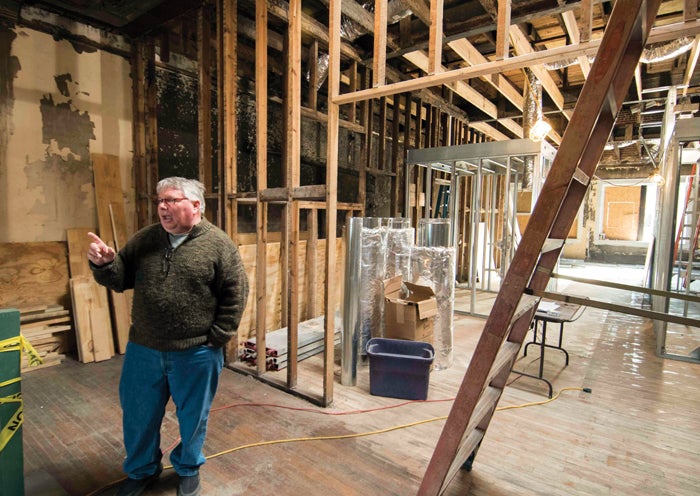My turn, Michael Young: Engineer’s study raises dated answers for downtown parking
Published 12:00 am Sunday, October 27, 2019

- JON C. LAKEY / SALISBURY POST Michael Young takes a walk through the old Okey Dokey & Co. building before its renovation. Young renovated it several apartments and retail space.
By Michael Young
To the city, parking is a traffic issue. To the Main Street Program, parking is a business issue. While the recent parking study commissioned by the city of Salisbury’s Traffic Engineering Department provided many of the same outcomes, let’s not lose sight of that.
The Main Street Program has spent 30 years fighting traffic engineers who put traffic above everything else.
What do I mean? A traffic engineer would propose spending $70 million to build a by-pass around a traffic slowdown like a downtown. A Main Street manager would propose using the same money to make the downtown the kind of place that motorists would like to slow, stop, have lunch, walk around, spend money and come back again. A traffic engineer will tell you how much a parking space will cost to build. A Main Street manager will tell you what that parking space is worth in gross retail sales and tax revenue for the city.
“Downtown does not have a parking problem, it has a walking problem,” Brian Davis, former director of the Historic Salisbury Foundation, once said. This is true, and the study said pretty much just that. But a one-day measurement of downtown parking will not produce a valid or reliable measure of downtown parking patterns.
Yet, that’s what they did to generate their findings.
On March 5, VHB Engineering determined, “The city of Salisbury does not currently have a shortage of parking supply to meet the existing demand, as there were more than 1,900 empty spaces observed during the peak period of 9 a.m.-11 a.m. in downtown Salisbury. During the peak morning period, only a 52% utilization rate of municipal parking was observed.”
Are you kidding? A peak period between 9 a.m. and 11 a.m.? Are we talking about Salisbury?
Retail stores open between 10 a.m. and 11 a.m. Restaurants open between 11 a.m. and 11:30 a.m. Many are closed on Monday.
If you were a business like a bank or retail store, you would staff your store based on time of day, day of the week and week of the month. Wednesday through Saturday at noon, you can’t find a parking space in the East Innes Street parking lot or on the street. The same holds for the 100 blocks of North and South Main streets, especially at the beginning of the month (when folks get paid or government paychecks). When court is in session, that applies to the 200 and 300 blocks of North Main Street and the side streets.
The study is flawed in this regard. But it also makes many points that the Main Street Program has been advocating for years.
The definition of a consultant is someone that will take your watch and tell you what time it is (and bill you for it). The study lists some short-term solutions, such as strengthening parking enforcement, adding bicycle parking throughout the city, deterring street parking by downtown employees, improving pedestrian safety, adding a paved parking lot with 60-75 spaces and address concerns for public service lots. Some long-term solutions are pursuing public-private development opportunities to add public parking, including a parking garage and evaluating potentially adding paid metered parking in heavily used spaces. And while it is beneficial to hear these things from an outsider, if history prevails, implementation of the recommendations is not likely to happen regardless. We are great at planning. We are equally great at implementation, in the inverse.
According to the Urban Land Institute, “the distance that a pedestrian will walk, is directly proportional to the number and types of impediments encountered.” In other words, shoppers are more likely to drive than walk from the 100 block of North Main Street to the 100 block of South Main Street if they fear for their life crossing at the Square. They will not park further away and walk around the block or take a short cut down a dark alley if they are afraid of twisting an ankle in a pothole, falling on broken glass and getting robbed.
Specifically, the speed of traffic on East and West Innes streets needs to be calmed and enforced. Crosswalks need to be better marked. Yield-to-pedestrian signs need to be installed. Impediments to remote parking need to be removed. Sensible parking enforcement on a regular basis needs to be implemented (and maintained). Déjà vu? Those are same things that Main Street has talked about and fought with the city about for 30 years.
If walking is the objective, a parking study, done by traffic engineers is the problem, not the solution.
Michael S. Young is a business owner, downtown developer and former Main Street Manager. He and his wife, Diane, renovated and live in the O.O. Rufty Building in Downtown Salisbury.

